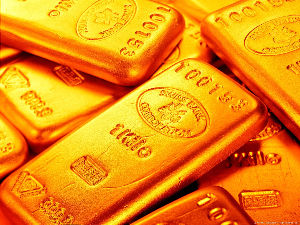
| |||||||||||||||

|
Gold
Introduction Gold, whose chemical symbol is Au, is malleable, ductile, and sectile, and its high thermal and electrical conductivity as well as its resistance to oxidation make its uses innumerable. Malleability is the ability of gold and other metals to be pressed or hammered into thin sheets, 10 times as thin as a sheet of paper. These sheets are sometimes evaporated onto glass for infrared reflectivity, molded as fillings for teeth, or used as a coating or plating for parts. Gold's ability to be drawn into thin wire (ductility) enables it to be deposited onto circuits such as transistors and to be used as an industrial solder and brazing alloy. For example, gold wire is often used for integrated circuit electrical connections, for orthodontic and prosthetic appliances, and in jet engine fabrication. Gold's one drawback for use in industry is that it is a relatively soft metal (sectile). To combat this weakness, gold is often alloyed with another member of the metal family such as silver, copper, platinum, or nickel. Gold alloys are measured by karats (carats). A karat is a unit equal to 1/24 part of pure gold in an alloy. Thus, 24 karat (24K) gold is pure gold, while 18 karat gold is 18 parts pure gold to 6 parts other metal.
| ||||||||||||||
| Be notified of page updates |
wwwswicofilcom2015



